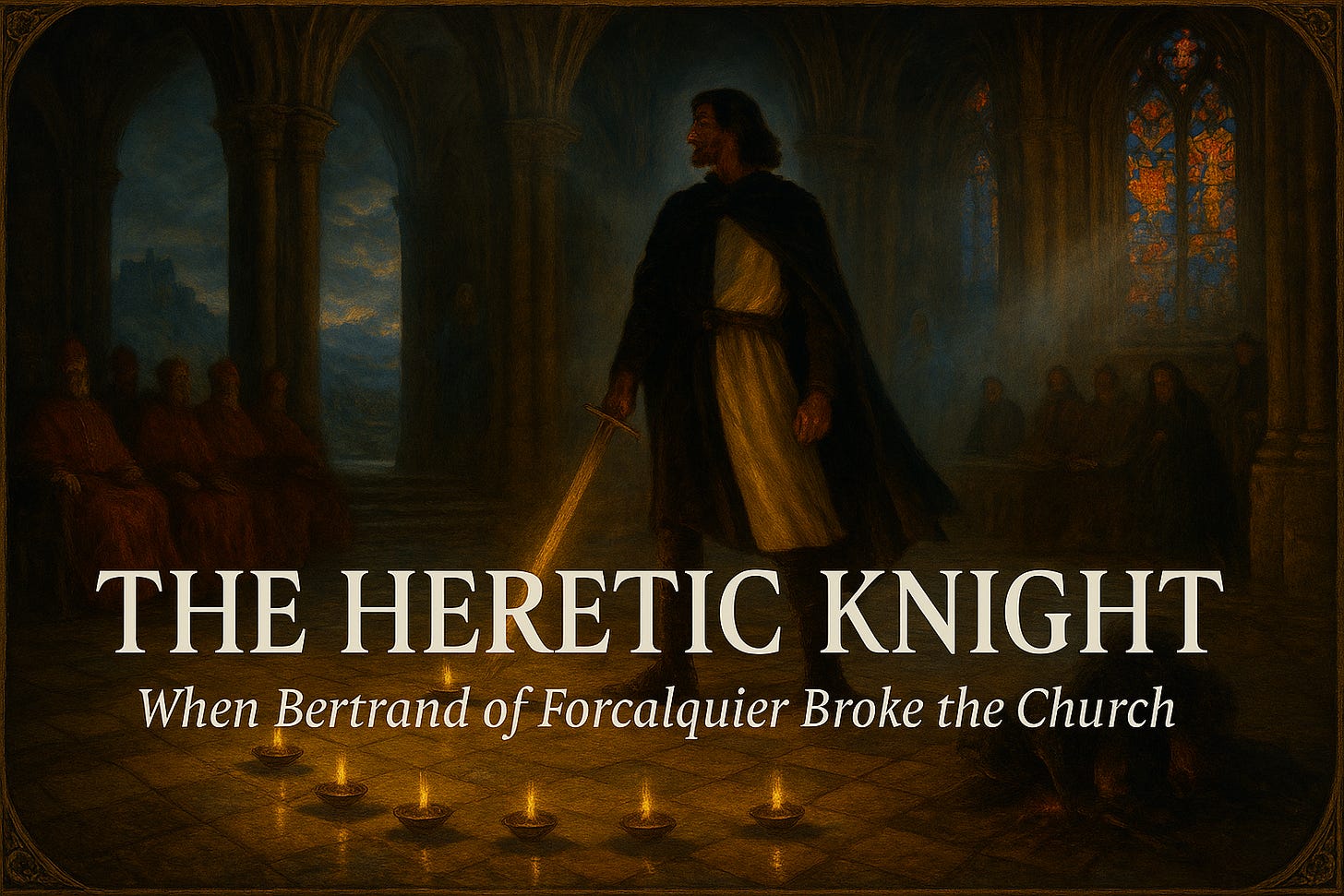The Heretic Knight: When Bertrand of Forcalquier Broke the Church
Because history doesn’t repeat itself—it remixes.
Prologue: The Real Background History
Between 1144 and 1162, the Baussenque Wars raged across Provence—a feud disguised as succession but animated by ideology, inheritance, and geography. When Countess Douce I of Provence married Raymond Berengar III of Barcelona, her dowry promised a Catalan future for the Rhône valley. Yet, upon her death, the counts of Toulouse claimed the same inheritance through their kinship with the elder line of Saint-Gilles. The Provençal nobility split. Some looked east to Aragon’s discipline and papal favor. Others, looked west to Toulouse’s charisma and local liberty.
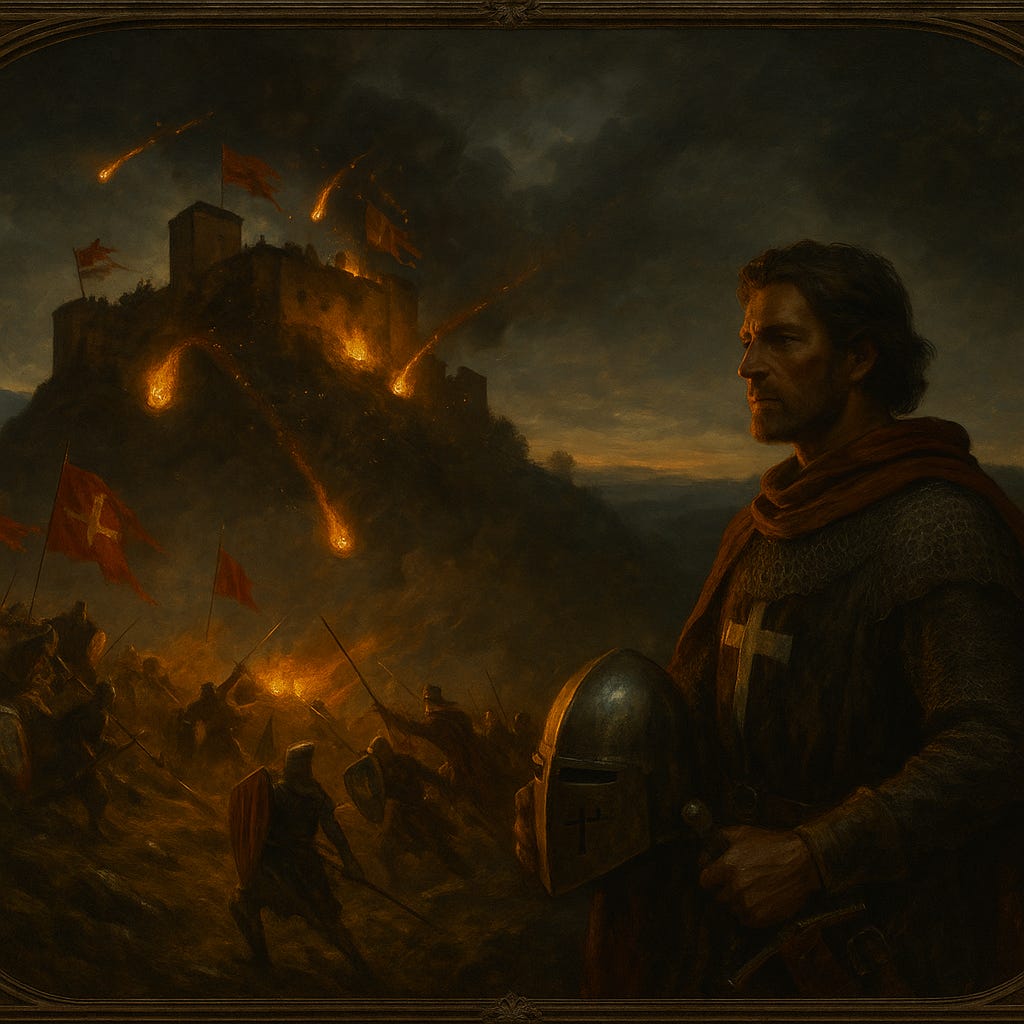
The war’s name came from the Siege of Baussenque near Draguignan: a fortress whose stones outlasted the men who swore upon them. Across eighteen years, castles changed hands, oaths shifted, and banners burned. But the greater fire was ideological: the south had begun to think differently. Wealth from trade, tolerance among faiths, and troubadour courts had made Provence a region of conscience as much as commerce.
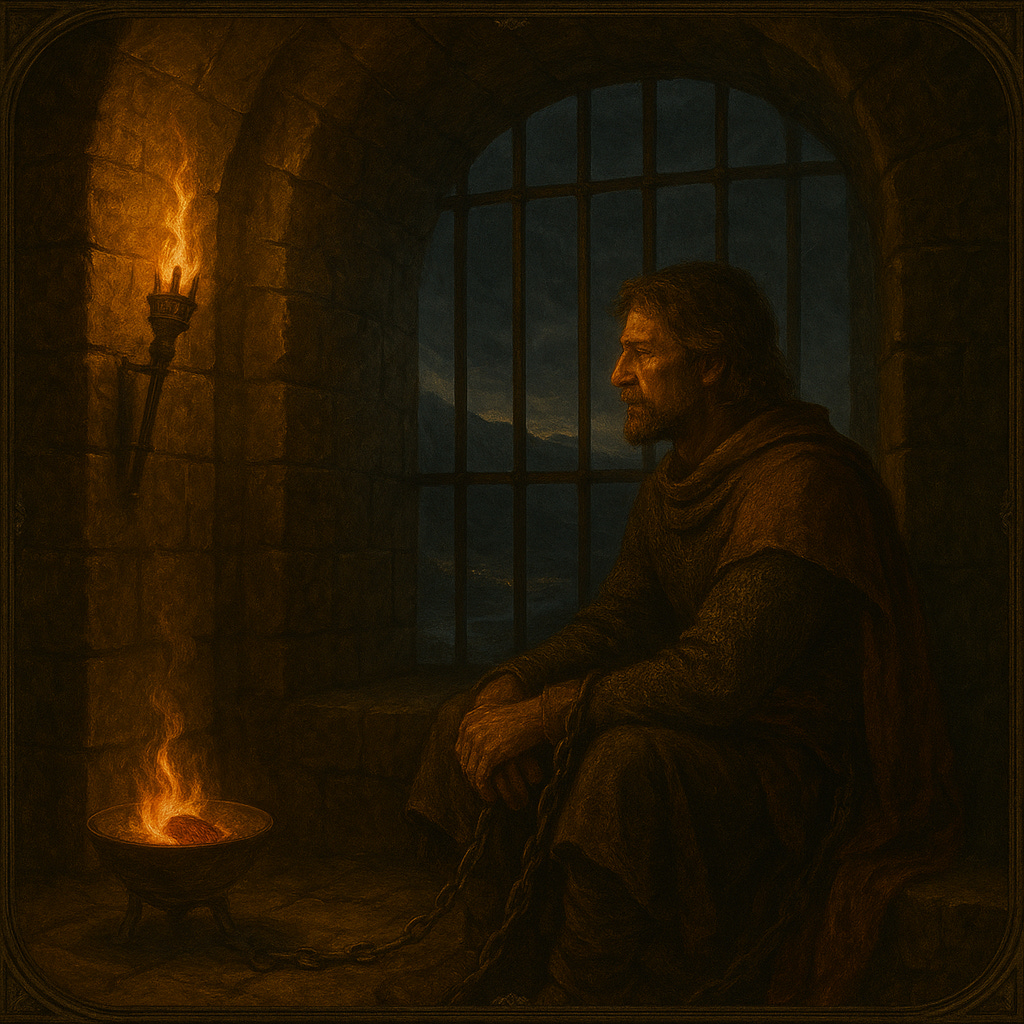
Into that ferment rode Bertrand I of Forcalquier, a minor lord by title, a pivotal one by temperament. He commanded a ridge country between Alpine valleys and the Durance plain. Too independent for Toulouse, too skeptical of papal legates, he fought first for one crown, then for the other, until both distrusted him. Captured in 1150 after an ambush near Sisteron, the chronicles fall silent.
His silence leaves the historian an aperture. What if the knight who vanished had emerged changed—not broken, but converted?

The real Bertrand disappears into stone and stillness. Our rerouted Bertrand will re-emerge into light and enliven an era. And an idea…
The Escape and the Light
Night pressed hard upon the keep of Sisteron. The moon hung like a wax seal above the Durance, its pale reflection slicing the black river in two. Within the dungeon corridor, a single candle guttered in a wall niche, painting the damp air with gold smoke. Bertrand of Forcalquier counted the wax drips as hours—the only calendar left to a man unmentioned in his own century.
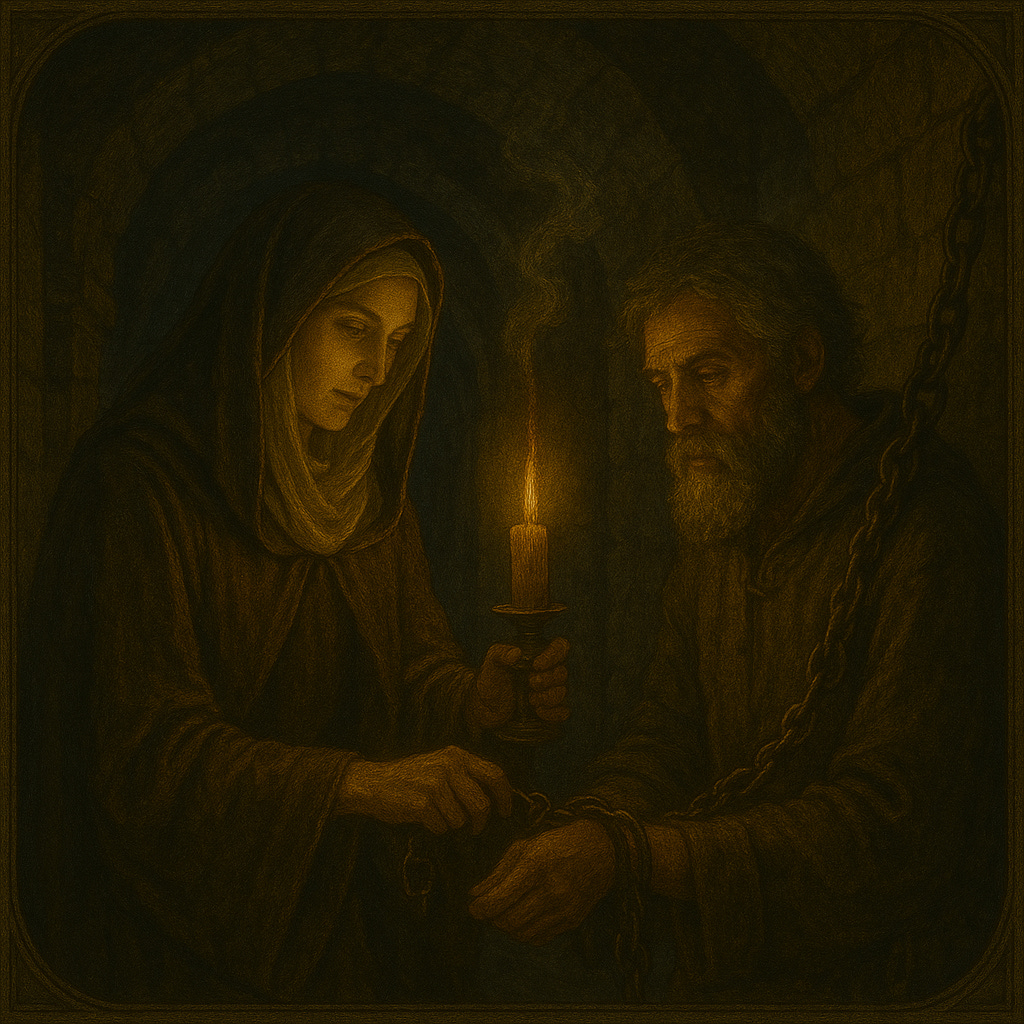
A footfall broke the rhythm. Two figures entered: a gaoler and a veiled woman. The man muttered the Latin of habit, handed over a ring of keys, and vanished into the stairwell. The woman’s voice followed—clear, provincial, and dangerously calm.
“Lord Bertrand, you have been forgotten above ground.”
He rose, chains clinking like argument. “Then why remember me now?”
“Because you once fought for a claim that never was. Would you fight now for a truth that always is?”
Her hood fell. Torchlight met the eyes of Esclarmonde de Rieux, a Perfecta of the Bons Hommes—those the Church named heretics, and the people called: “pure ones.” She carried no cross, only a black book bound in linen.
Outside, the wind deepened. Within, she unlatched the shackles and pressed the cold key into his palm. “Follow the wind. It knows our path.”
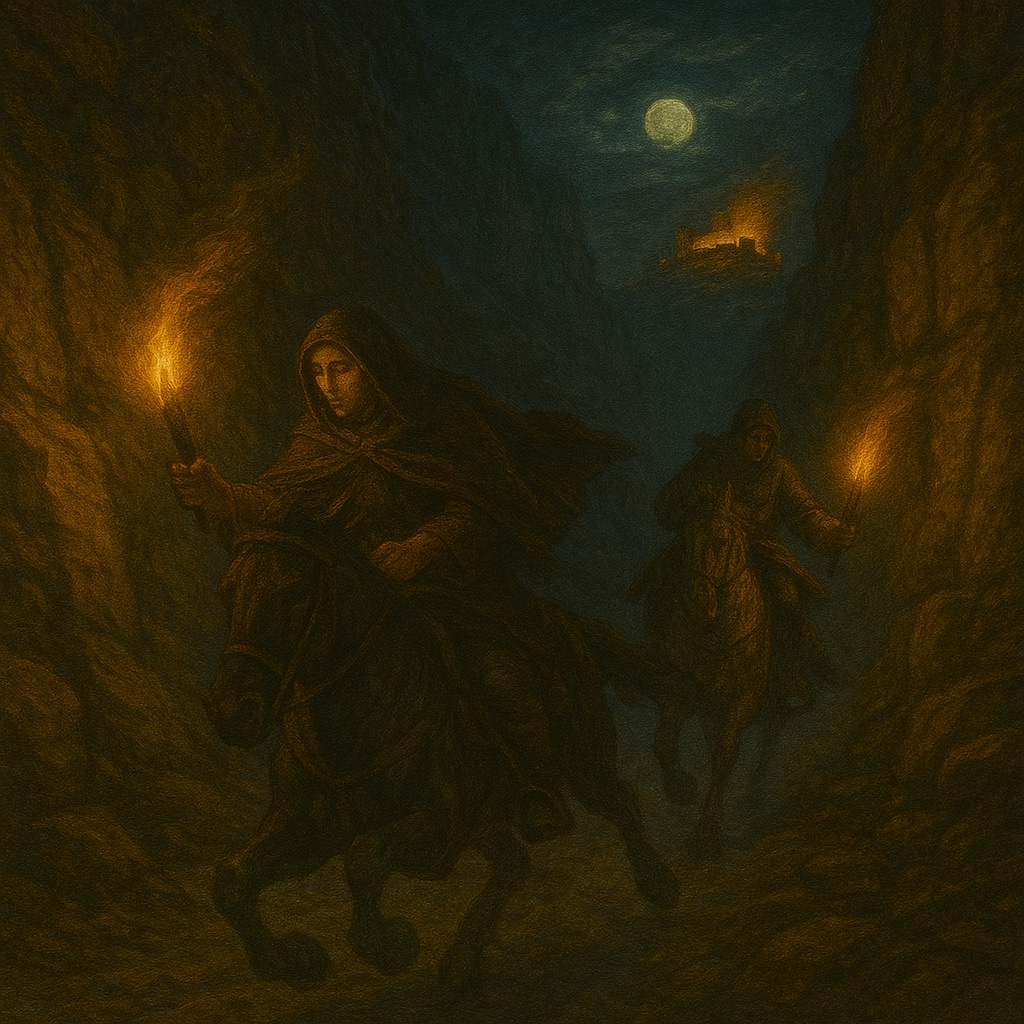
They fled through an unused culvert that spat them into the gorge below the fortress. From there, the Durance gleamed: a river as divided as their faiths. They rode south under a waning moon, guided by a star the monks would have called false.
At dawn, they reached a ruined hermitage carved into the limestone. Within its apse, there stood three figures in gray, each holding a small oil lamp. The scent was not incense but olive and ash.
Esclarmonde spoke: “This is the light the Church has hidden. Will you kneel before what it forbids?”
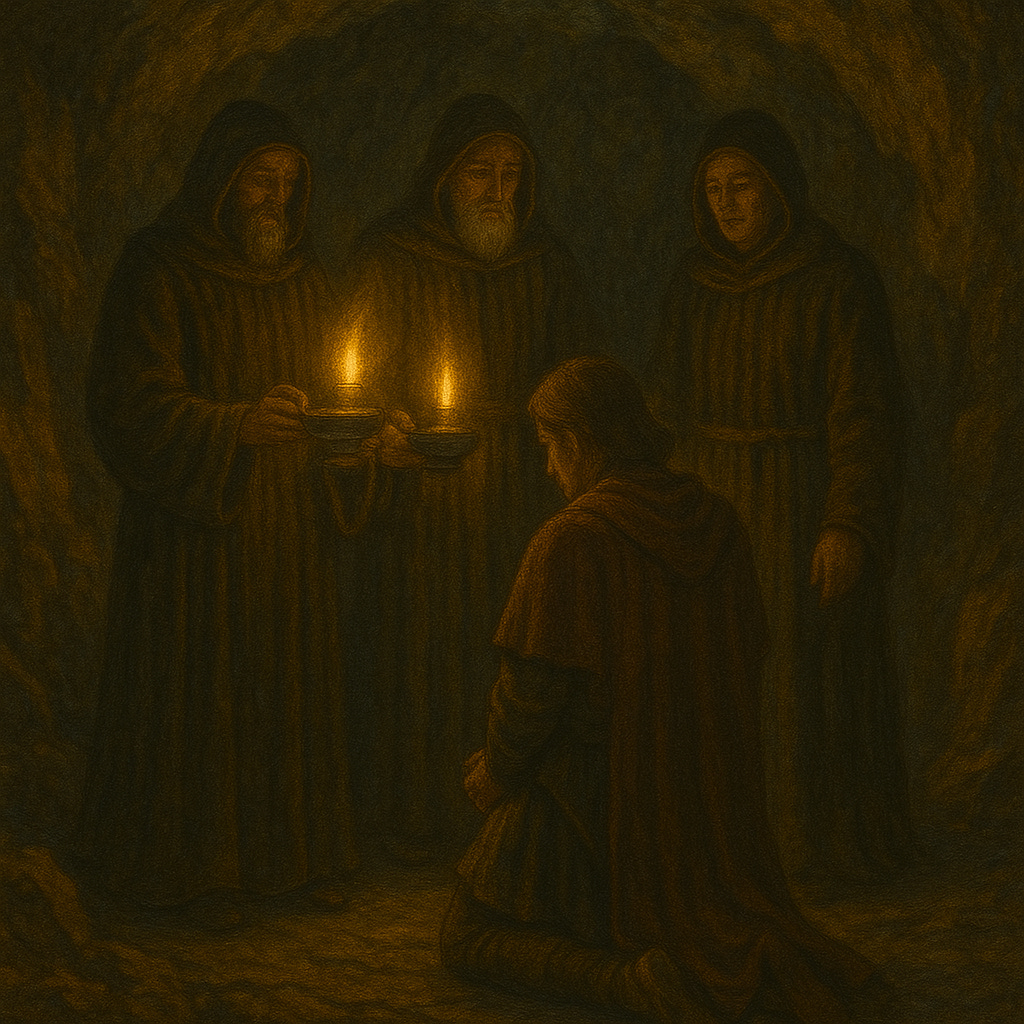
Bertrand’s knees met dust. The eldest Perfectus stepped forward, fingers tracing the air above the knight’s brow.
“Two worlds,” he intoned: “one bright, one shadowed. Both born of the same breath.”
A second lamp was placed beside the first. Together they threw twin circles of gold and soot across Bertrand’s face.
He whispered: “If there are two lights, why must one conquer?”
The elder smiled—a movement more sorrow than mirth.
“Because men mistake unity for victory. You will teach them otherwise.”
They fed him bread baked without yeast—the panis sincerus of the dual faith—and water drawn from the same spring that once baptized Roman legionnaires. Then, while dawn reddened the cliffs, Esclarmonde drew from her satchel a strip of white cloth embroidered with a half-sun.
“This is no order of monks,” she said. “It will be yours to found. A knighthood of light. Fight, but never to rule. Defend, but never to own.”

Bertrand took the cloth. It trembled between his fingers like a living oath.
By nightfall, Sisteron’s watchmen reported a fire in the gorge—a pyre of abandoned armor. They assumed another outlaw had met divine judgment. But from that same fire, a single horse rode east, its rider bearing a split banner: one half gold, one half black, rising into the wind like an argument answered.
The Real Hierarchy of the Perfect and the Faith of the Dual

Between 1140 and 1220, the Church of the Bons Hommes and Bonas Femnas flourished quietly from Albi to Alès, from Toulouse to Lombardy. It was a parallel Christianity—organized, literate, and astonishingly humane. Its records survive not in triumphal chronicles but in depositions, fragments of the Summa contra haereticos (1178 – 1180), and the Liber Sententiarum Inquisitionis Tolosanae compiled later by the men who hunted them.
Where Rome spun hierarchy with gold, the Cathars inverted the pyramid. At the summit stood the Perfects—the perfecti—spiritual elders who lived in absolute poverty, renounced meat, oath, and violence, and moved constantly between mountain towns carrying a portable gospel. Below them were the believers, ordinary citizens who practiced trade and family life but awaited the rite of consolamentum, a single laying-on of hands believed to cleanse the soul’s long captivity in flesh. No baptismal font, no altar rail, no tithe: their church could fit into a cottage, a barn, or a hillside.
The dualism that alarmed the papacy was…reasoning. Whether right or wrong, they thought. They thought for themselves. Instead of having it “interpreted” for them in a language out of their reach intentionally. They held that two principles: Good and Evil—had co-eternal force. They asked all to live gently, to harm no life, to swear no false oath—these were not protests but proofs that light endured inside darkness. Kindness,
Yes, they swore off all material possessions. But didn’t The Church require that of those, as well? Well, those who didn’t already have those possessions?
The Summa contra haereticos by The Church condemned this as: “the madness that makes angels of men and demons of matter.” Yet, beneath the accusation lay admiration for their orderliness. A single perfectus might carry ten copied gospels, each in the vernacular Occitan that Rome refused to bless. In their simplicity was subversion: if any man or woman could read the Word, no bishop could own it.
By the mid-twelfth century, this creed already threaded the valleys Bertrand rode through. Sisteron’s caves hid their libraries. Albi’s merchants funded their journeys. Our knight did not invent their fire: merely gave it armor and a banner.
The Founding of the Militia Lucis
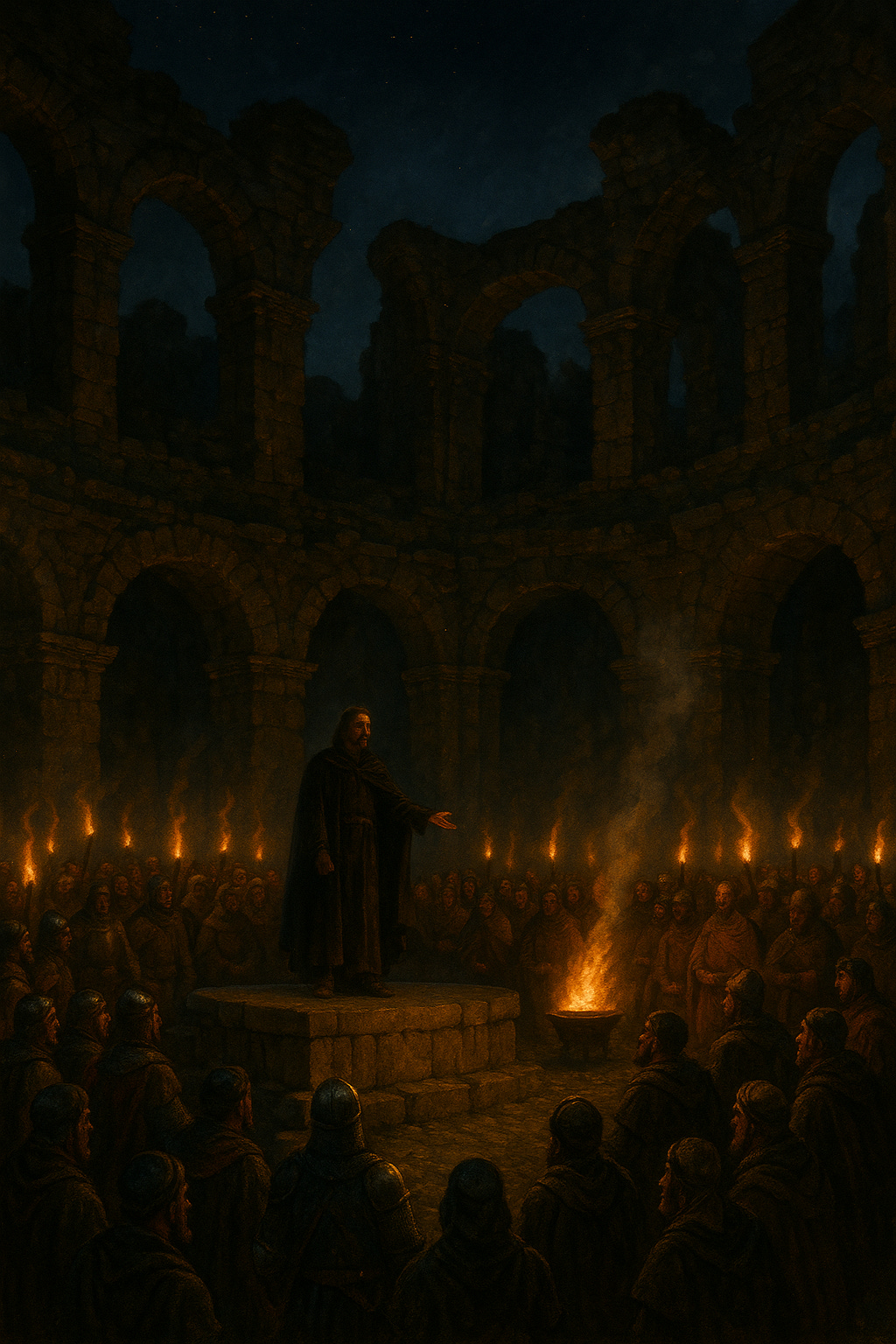
By the spring of 1153, the snows had melted from the passes above Forcalquier. The orchards dripped with thaw, and the roads that once carried armies now bore only silence. Bertrand rode them again—not as a vassal, nor as a fugitive, but as a pilgrim building something that had never existed: a knighthood consecrated to conscience.
He gathered them slowly—dispossessed squires, debtless merchants, even a pair of Cistercian novices who had grown disillusioned with their abbots’ gold. They met first in a ruined Roman amphitheater at Apt, its terraces carved with ivy and memory. No trumpets, no heraldry, only torches and breath.
Upon a marble block where emperors once addressed legionnaires, Bertrand set the half-sun banner that Esclarmonde had given him. “We are all captives of the two lights,” he began. “One blinding, one revealing. The world calls them day and night, but the soul knows them as self and truth. To serve them both is our calling.”

The words were not sermon but statute. In the weeks that followed, those who joined him signed their names—or marks, or thumbprints—onto a single parchment. It would become known as the Concordat of Apt, written in the Provençal tongue rather than Latin. Its clauses were few, its spirit immense:
The knight shall swear no oath save the Oath of Light.
He shall possess nothing he cannot defend with mercy.
He shall draw steel only to prevent greater darkness.
He shall answer not to king nor count but to the Conscience in Council.
He shall pay tithe not to bishop nor abbot but to the hungry.
This was no rebellion in form. No, it was simple. A rebellion of fluency of the people. The very use of Provençal—the language of troubadours, not theologians—declared independence. To write law in song was to reclaim speech from scripture cloistered away from “unworthy” eyes.

The first initiation took place at twilight. The amphitheater floor was strewn with olive branches, symbol of peace renewed, and small stones gathered from local fields—each marked with a cross and a crescent. The pluralism of ancient Rome pulsed.
The candidates entered barefoot, laying their swords upon the ground. Bertrand stood at the center, cloak half white, half black, the dual colors catching firelight like living doctrine.
He asked the ritual question: “Do you swear to guard the weak?”
The answer came: “I guard, that I may not rule.”
“Do you swear to tell the truth even to your shame?”
“I tell, that I may not own.”
“Do you swear to walk in both lights?”
“I walk, that both may shine.”
Then, instead of an anointing, he lifted each sword by its blade, not its hilt, and held it to the flame until the metal glowed dull red. When cooled, every weapon bore a shallow line etched by the heat—one edge bright, one dark. The mark of the Militia Lucis.
They fought no wars that year. They rebuilt bridges, ransomed prisoners, and escorted traveling merchants through brigand valleys. Their fame spread faster than their number. The bishop of Sisteron called them: “the wandering schism,” yet even he dared not excommunicate men who healed lepers and fed the poor.
By 1155, they had a hall—a monastery without vows—on the hill of Saint-Maime. There, Bertrand drafted the Rule of the Two Lights, sixty-eight articles blending Cathar dualism with the chivalric code. It required every member to learn to read, to study both Latin and the vernacular, to debate scripture without violence. Their libraries contained the Gospels, Aristotle in translation, and fragments of Persian wisdom carried from traders in Narbonne.
Esclarmonde returned that summer, her veil weather-stained but her spirit bright. “You have given the heretics an order,” she told him, “and the knights a conscience. They will call you dangerous.”
Bertrand smiled: “If danger means remembering that light is patient, then let it burn.”
In the courtyard below, recruits sparred beneath banners of gold and black. To onlookers, it looked like training. To those who listened closely, it was prayer in motion. Each strike answered by restraint, each parry by silence. War transformed into liturgy.
The rumor reached Rome within a season: “A new order has arisen in Provence, owing allegiance to no prince, preaching peace with swords.” Papal couriers began their descent from Avignon, carrying parchment more perilous than any lance.
The Militia Lucis had been born. Its creed would soon be tested by the world that feared light.

The Real Politics of the Late Baussenque Wars
By 1156, the Baussenque conflict had ceased to resemble a local feud and had become a continental chessboard. Each piece moved not for Provençal soil but for its symbolic weight.
The Papacy, still scarred by the schisms of Anacletus and Innocent II, viewed the southern marches as a test of obedience. Whoever held Provence held the gate between Latin Christendom and the heterodox east. Papal letters to Aragon—preserved in the Regesta Honorii—promise: “absolution and indulgence for all who lift the banner of Douce’s heirs.” In practice this meant subsidies for Catalan troops, relics for morale, and friars to supervise the story told in every pulpit.
The Empire, under a newly crowned Frederick Barbarossa, watched without committing. He needed Arles to remain formally imperial but functionally neutral—a crown he could claim without wearing. His legates, Dietrich of Metz and Rainald of Dassel, traveled the Rhône in 1157 to negotiate safe passage for imperial merchants, not salvation for Provençal souls. They left laden with salt contracts and silence.
Aragon and Toulouse fought the real war of measure: money, loyalty, time. Aragon bought papal grace, Toulouse bought hearts. Both bled men into sieges that achieved nothing but famine. When the harvest of 1158 failed, garrisons deserted to whichever side promised bread.
Within that exhaustion, new actors found space to breathe. The troubadour courts spread vernacular scripture disguised as song. Cistercian reformers debated obedience before the chalice. And amid it all, reports reached both Rome and Aragon of a knightly brotherhood in the Durance valley that claimed allegiance to neither camp.

By 1160, papal envoys listed the Militia Lucis among “the unclassifiable sects of the Rhône.” To the strategists of the war, this was heresy. To its weary survivors, it was hope.
The Council of Arles and the Two Lights
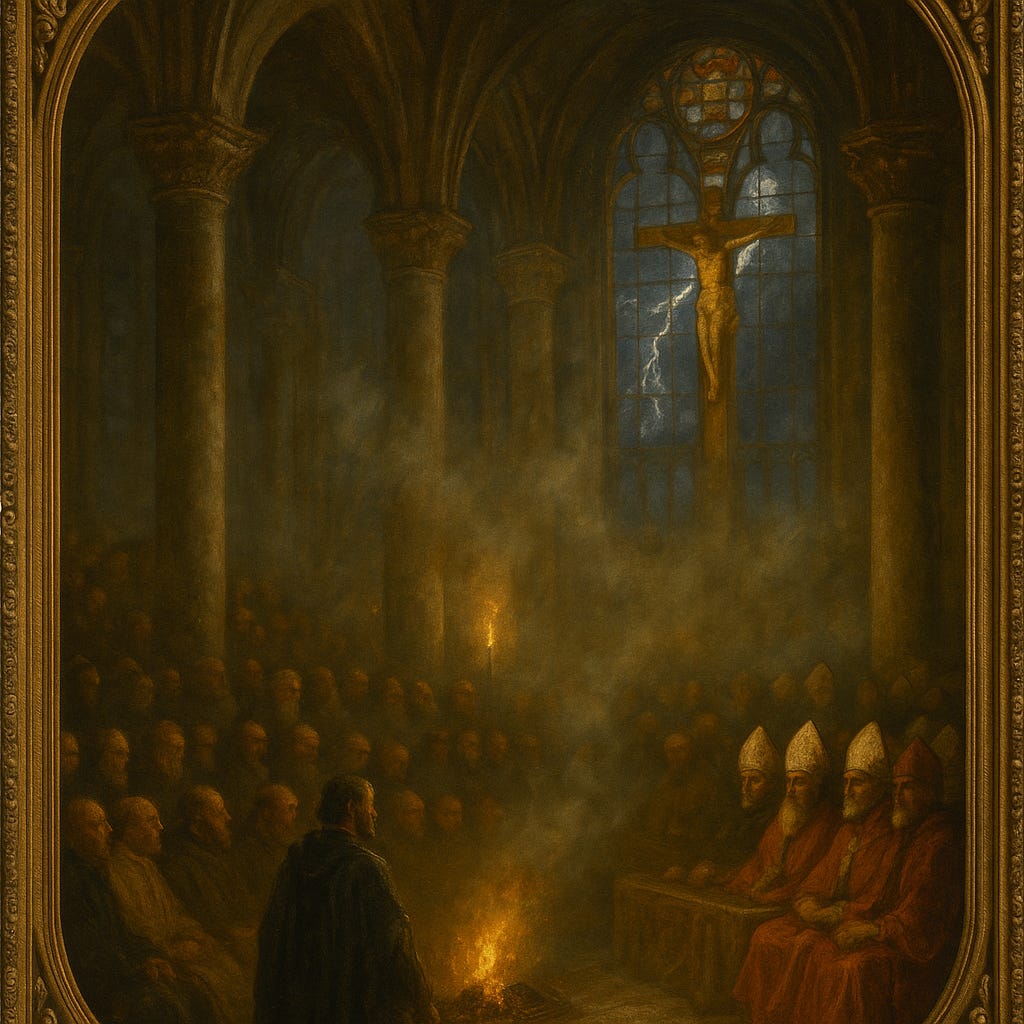
The spring of 1161 brought thunder down the Rhône. From Avignon to Aix, bells rang for a council convened: “to restore unity to the southern Church.” Bishops arrived with jeweled croziers. Abbots with purses heavy from Aragonese tribute. Soldiers lined the cloisters of Saint-Trophime of Arles, a cathedral half fortress, half reliquary. And before the altar where relics of Saint Stephen lay sealed in glass, a seat stood empty—reserved, by papal order, for the: “heretic knight of Forcalquier.”
When Bertrand entered, the murmuring ceased. He wore neither mail nor silk, only a rough tunic split in color: white to the right, black to the left. Behind him marched twelve companions of the Militia Lucis, each carrying an unlit lamp. The air smelled of rain and fear.
Cardinal Octavian rose first. His voice was parchment—thin, formal, precise. “Bertrand, son of William, you are accused of dualism, rebellion, and the forging of an unlawful order. What say you?”
Bertrand bowed. “That dualism exists only in eyes that refuse to see depth.”
A ripple of disapproval. The cardinal pressed on.
“You divide what God has joined. You make light equal to darkness.”
“I reveal that light is patient,” Bertrand replied: “and darkness is merely its shadow. To deny the shadow is to deny the sun.”
The council erupted—half outrage, half fascination. Octavian struck the marble rail with his staff. “Blasphemy! You claim the Devil a servant of God!”
Bertrand stepped forward until torchlight gilded the burn-scar on his sword’s edge.
“I claim that the Devil is the wound in every man, and that to heal it is holier than to hate it.”
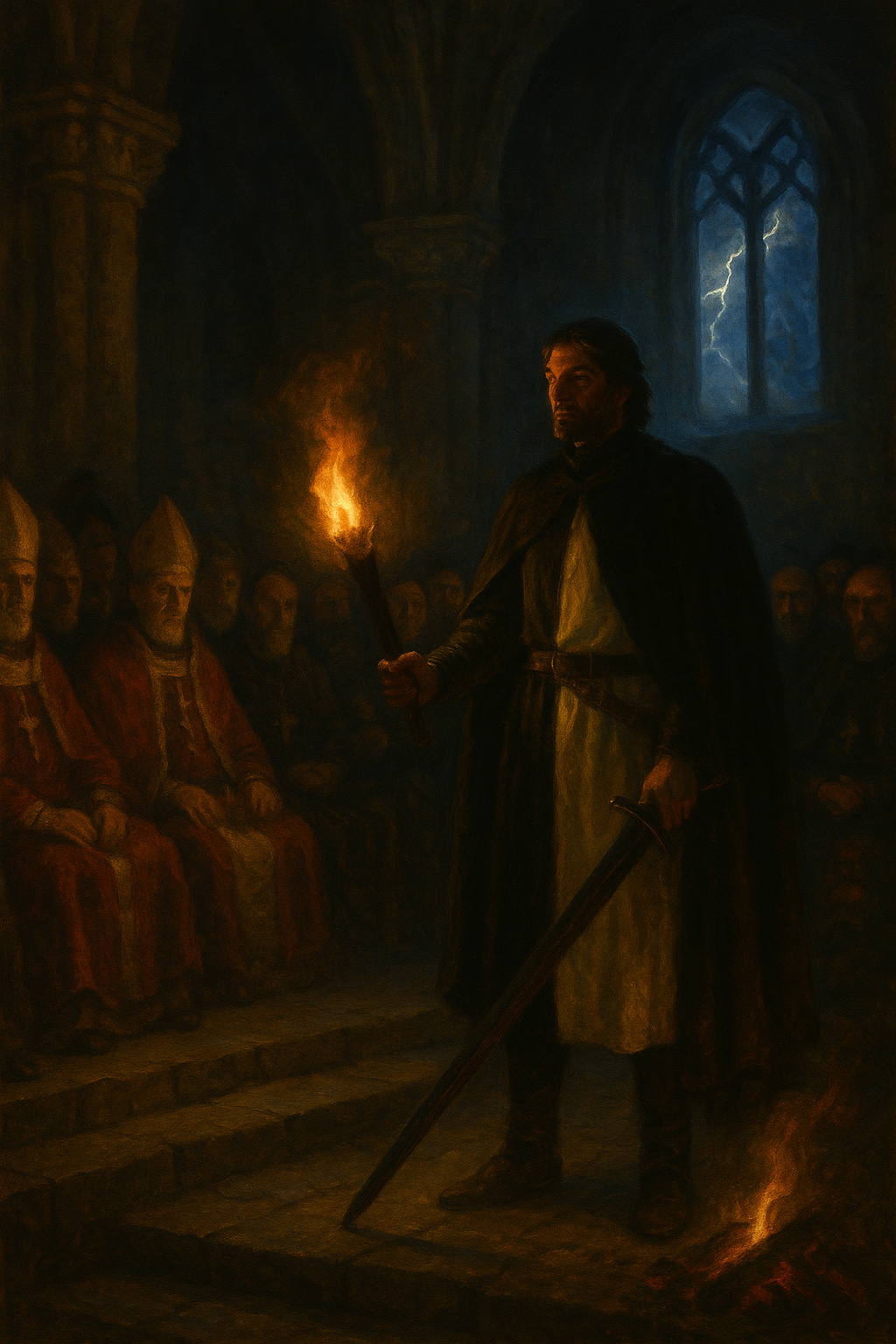
From the clerical ranks came murmurs of sympathy—the bishops of Nîmes and Maguelonne, men who had seen famine and found Rome distant. One rose and asked softly: “Then why an order of knights? Why arm those who preach peace?”
Bertrand turned to the assembly. “Because the world is deaf until steel rings upon stone. We fight so that others may stop fighting.”
He lifted the half-sun banner and unfurled it before the crucifix. “Two lights in one heaven. If they meet, they do not destroy each other—they complete each other. The sword must remember mercy, and the faith must remember doubt.”
The crowd stilled. Even the thunder outside paused between rolls. A chronicler later wrote: (Chronicon Provençale, imagined from surviving style) that: “for one heartbeat Arles held its breath between heresy and revelation.”
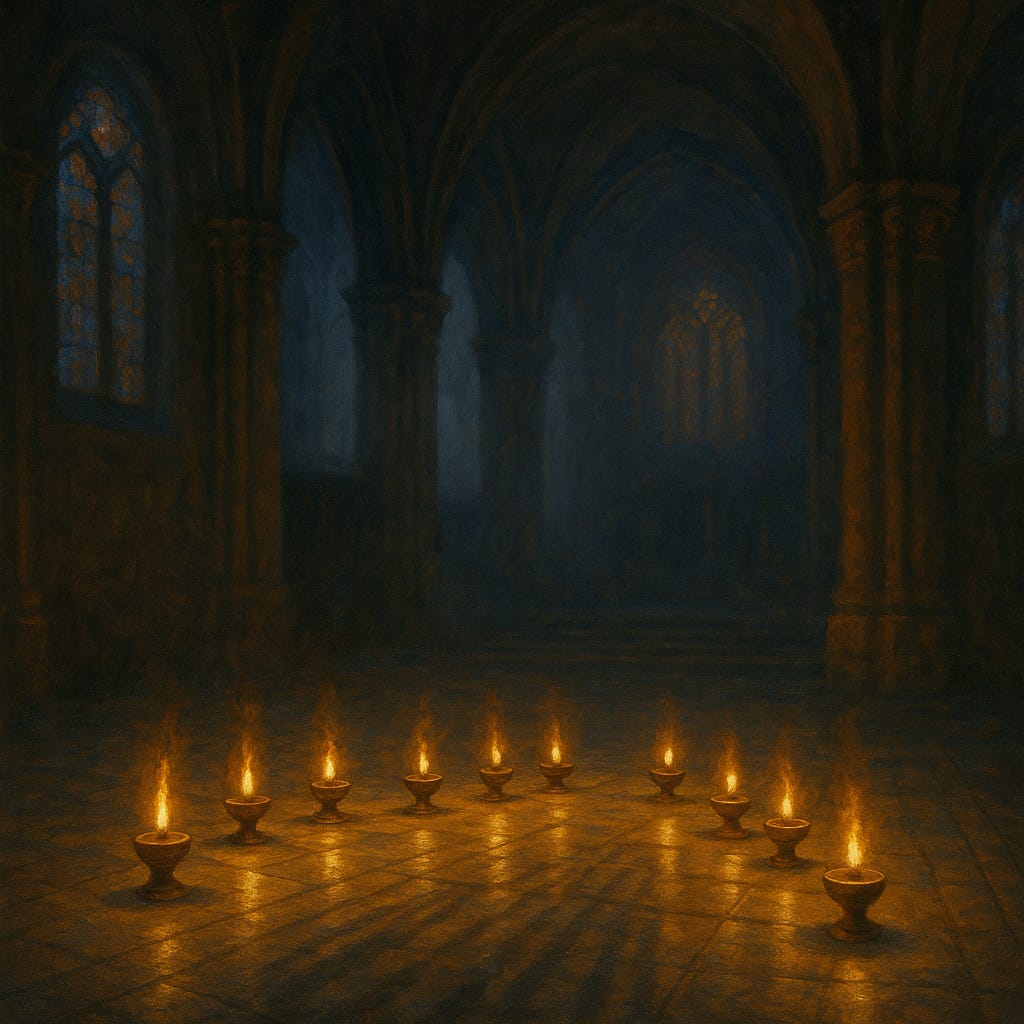
Octavian’s verdict was pre-written. “You are excommunicated. Your followers dispersed. Your lands forfeit to the rightful heirs of Barcelona.”
Bertrand smiled, serene as if freed. “Excommunicate light, then, and see if darkness obeys.”
He turned to his knights. “Leave the lamps.” One by one they set them upon the cathedral floor and withdrew. The council expected them to be extinguished. Instead, each wick caught from the next—twelve flames blooming across the nave, gold upon marble, stubborn and still.
By dusk, the papal legates had departed to draft decrees. By dawn, the citizens of Arles were already whispering of “the Twelve Lights.” Pilgrims carried the tale north to Autun and west to Toulouse. To some it was defiance; to others, deliverance.

Within a month, copies of the Concordat of Apt circulated in the markets, bound in cheap vellum, its preamble rewritten in troubadour meter:
One faith of two flames,
One God of two names,
One world made whole by mercy.
The Church would try to burn the verses. The wind would memorize them first.
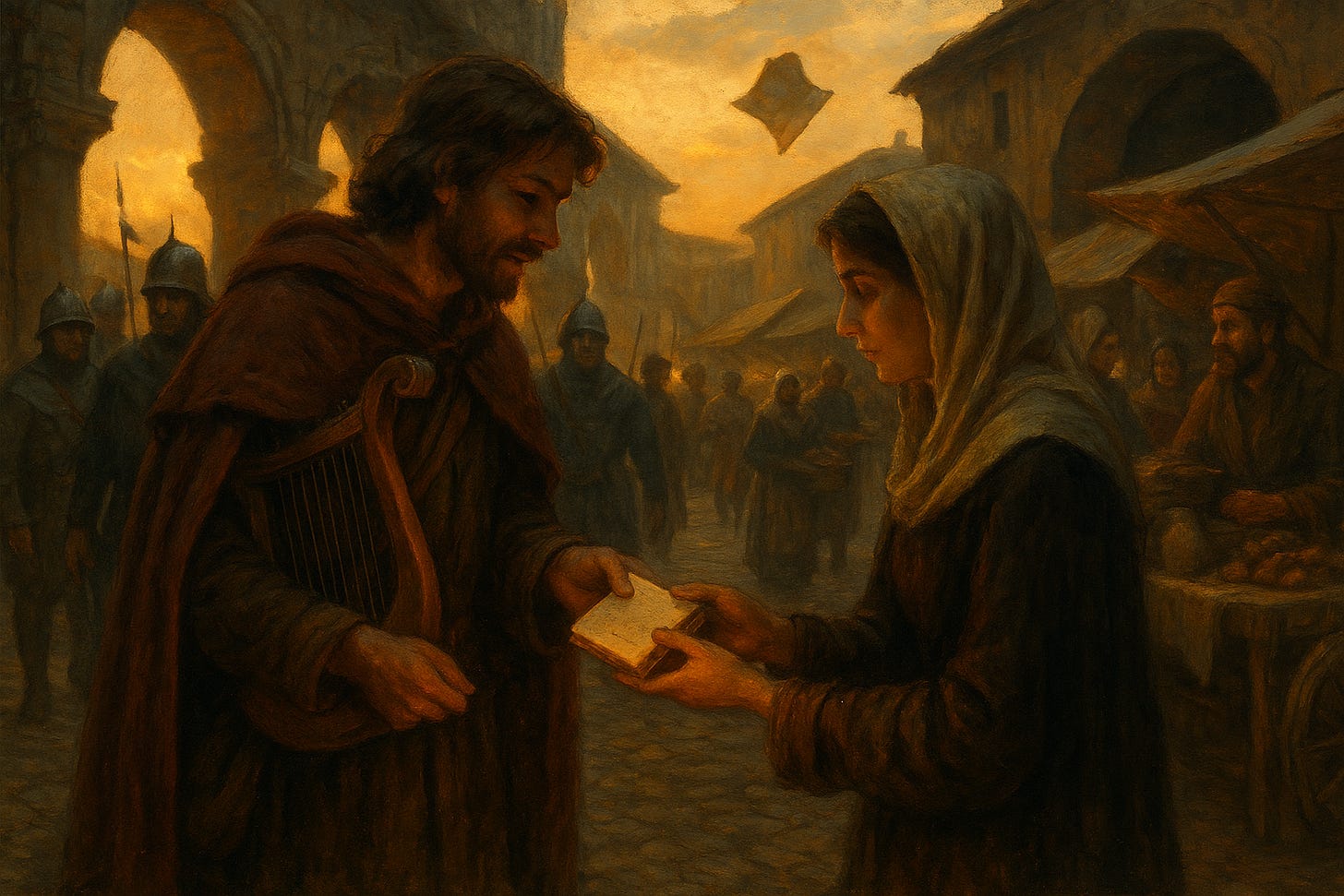
Europe Reconfigured
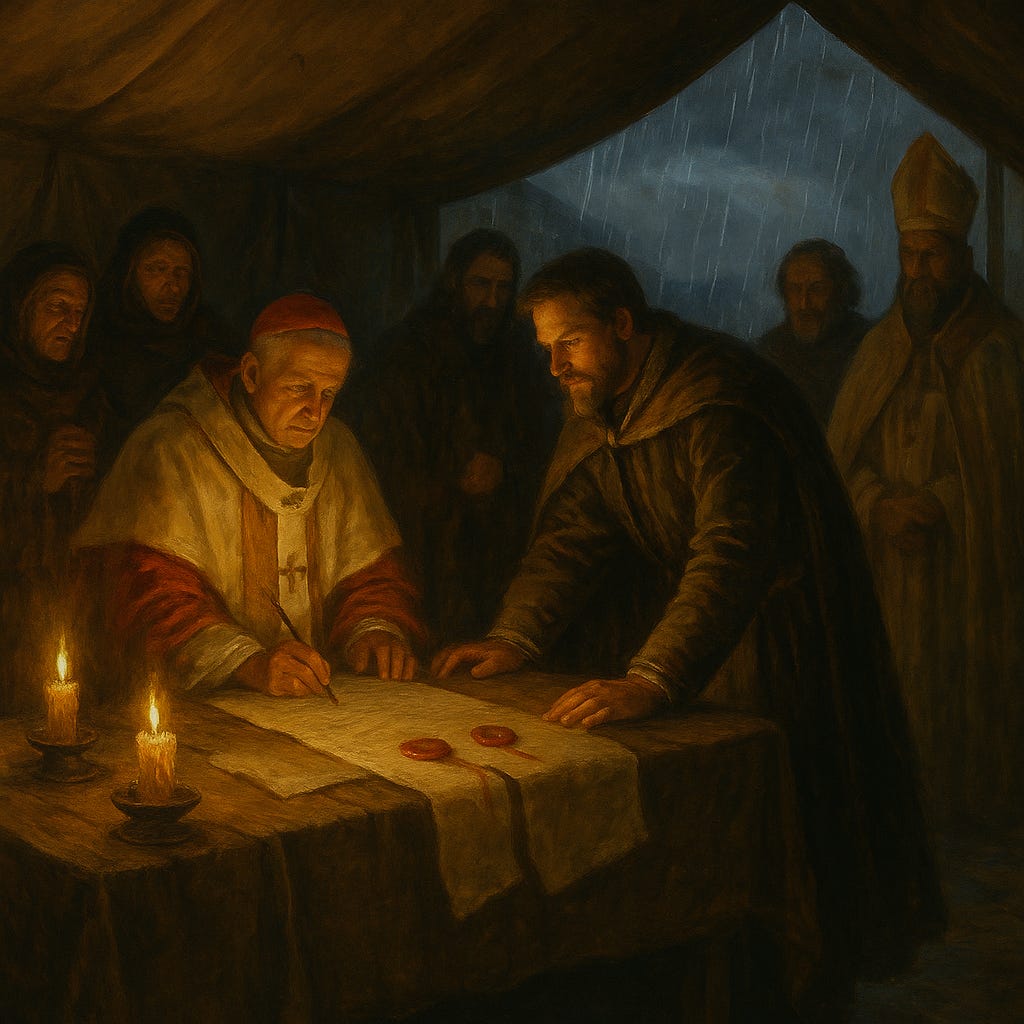
The fire at Arles did not end the Militia Lucis. It began Europe’s first reformation by persuasion rather than pyre. The papal decrees against Bertrand reached Provence months later, but their ink dried faster than their intent. Bishops hesitated to proclaim them. Merchants refused to fund the burnings of men who had once guarded their caravans. Peasants whispered that the knight of Forcalquier had made peace with both heavens.
By 1170, every major town from Orange to Béziers had adopted a local Concordia Lucis—city statutes blending canon with conscience. The new civic oath required each magistrate to: “protect the poor as proof of piety.” The idea spread faster than Rome could name it heresy. The papacy, bruised by Barbarossa’s wars in Lombardy, chose negotiation over crusade. In 1179, Pope Alexander III convened the Treaty of Saint-Gilles: a concordat that recognized southern diocesan autonomy in exchange for loyalty. It was a bureaucratic miracle—heresy legalized by exhaustion.
The Inquisition never came to be. Without a war to justify its instruments, the machinery of suspicion was never built. Instead, councils of inquiry were held by mixed juries of clerics and lay scholars—the embryo of the university system. By 1185, the Studium Generale of Montpellier taught logic beside gospel, medicine beside miracle. Women, permitted under the Lucis rule to interpret scripture, became instructors of conscience in convents turned schools. Esclarmonde de Rieux died there, revered as Mater Luminis.
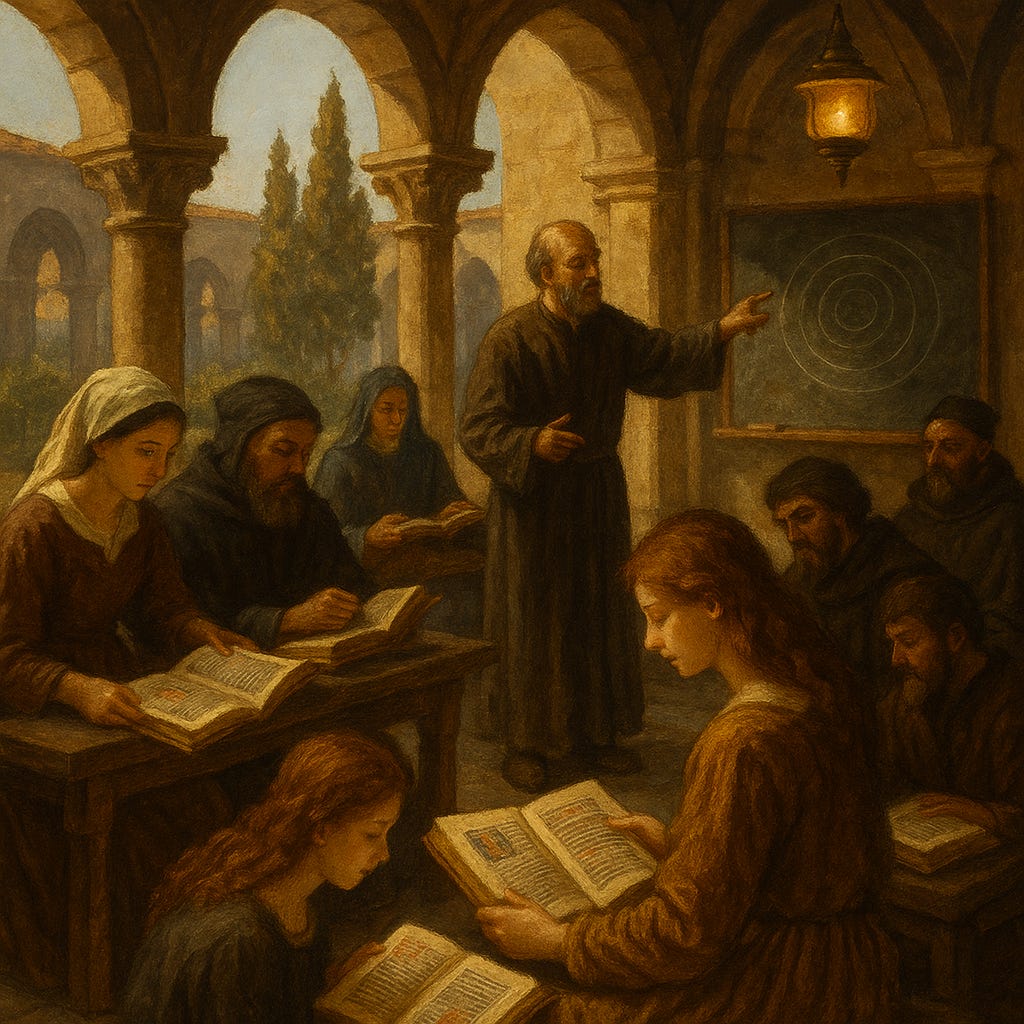
Across the Mediterranean, Sicily’s multicultural court under William II adopted the Provençal code, writing royal charters in both Latin and Arabic. Venetian merchants financed the translation of Lucis texts, and a generation later the Rhineland mystics would cite them as: “the southern light.” Even the crusader ports of the Levant carried copies of Bertrand’s Rule of the Two Lights, preserved by Hospitallers who found its balance between faith and mercy irresistible.
When the century closed, Christendom had not fractured—it had federated. Rome remained Rome, but it ruled through dialogue, not dread. The cathedral and the marketplace shared a single principle: “that conscience, when measured, is divine order incarnate.”

Bertrand’s grave was never found. Some say he fell defending pilgrims near the Durance. Others that he vanished into the Alps, leaving only the banner folded in his saddlebag. What remained were the lamps. Each year on the eve of Pentecost, the citizens of Arles lit twelve along the nave of Saint-Trophime. No inscription marked them—only the paired hues of flame: gold and shadow intertwined.
And in that mingling of lights, the medieval world stepped one stride closer to the modern one.



